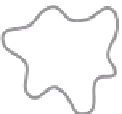Biomedical Engineering Reference
In-Depth Information
IL-1β
Neutrophilic inammation
IL-4
IL-13
Inammasome
activation
TGF-β1,
PDGF,
OPN
Fibrosis
Alternative
activation
Carbon
nanotubes
Membrane disruption
&
ROS release
Macrophage death
& tissue injury
Frustruated
phagocytosis
Macrophage
Bridge
formation
Impaired CNT clearance,
activation, death?
TNF-α
TGF-β1
Granuloma formation
Macrophage fusion &
multi-nucleated giant cell formation
FIGURE 10.3
Illustration depicting the macrophage uptake of CNTs and possible outcome
on macrophage biology and function.
activation of macrophages or whether Th2 cytokines influence CNT-induced inflam-
masome activation.
CNTs disruption of macrophage function is also determined by tube length. As
shown in Figure 10.3, long, rigid CNTs cause frustrated phagocytosis, which subse-
quently causes cell death and release of ROS and cytokines, leading to tissue injury
(Donaldson et al. 2010; Murphy et al. 2012). In addition to frustrated phagocytosis,
CNTs align to form bridge-like structures that link two or more macrophages. These
structures have been observed in rats exposed to SWCNTs by intratracheal instilla-
tion (Mangum et al. 2006). CNT bridge structures could represent a molecular inter-
action between the tube-like nanomaterial and the cytoskeleton and likely impair
macrophage function.
The cellular signaling responses to CNTs are complex and at least some of these
pathways are common to those activated by a variety of other particles and fibers.
For example, CNTs increase levels of the COX-2 enzyme through a MAP kinase-
dependent signaling pathway in mouse RAW267 cells
in vitro
(Lee et al. 2012).
CNTs also activate the antioxidant mediator Nrf2 in cultured human THP-1 cells
(Brown, Donaldson, and Stone 2010). Both COX-2 and Nrf2 are protective factors













































































































Search WWH ::

Custom Search